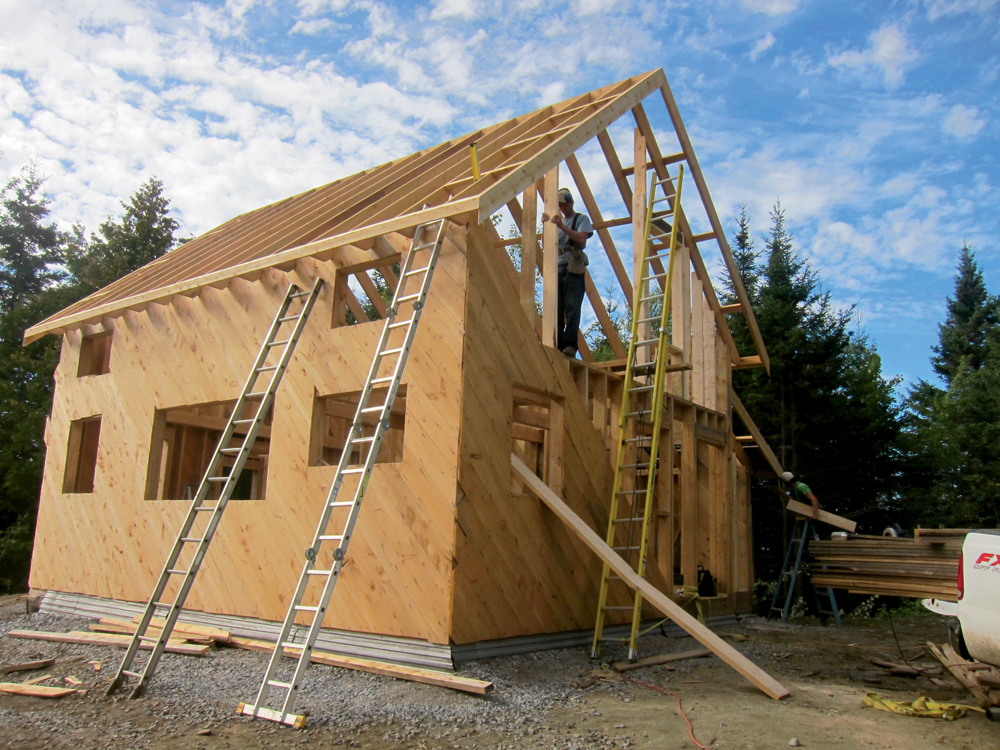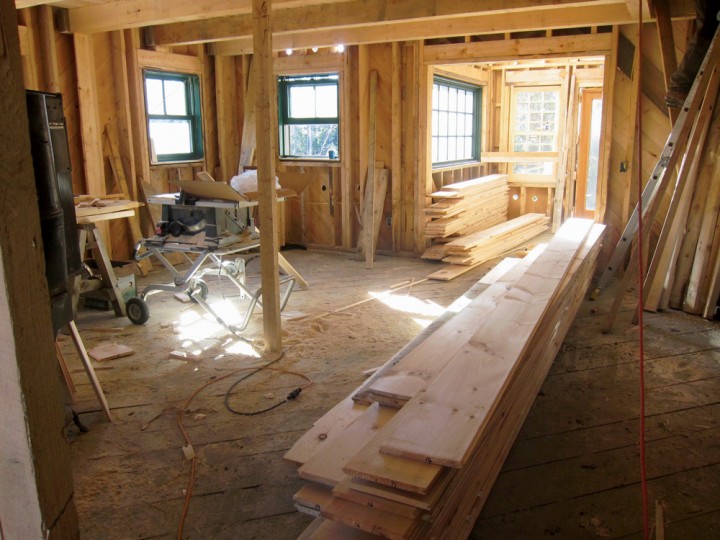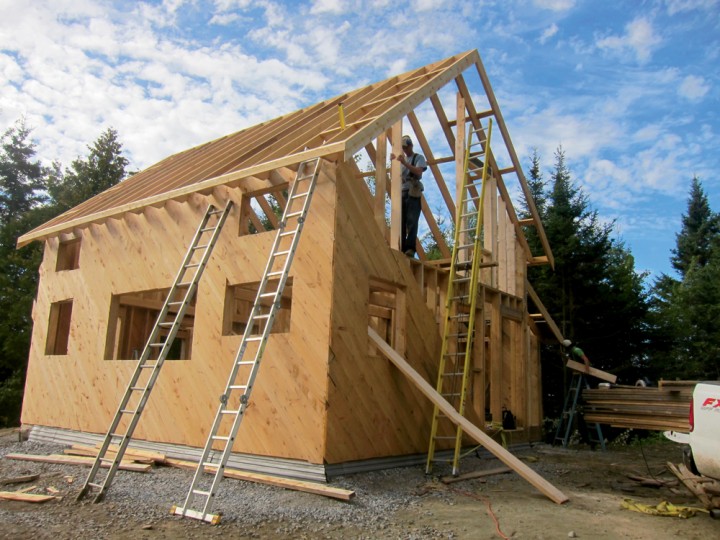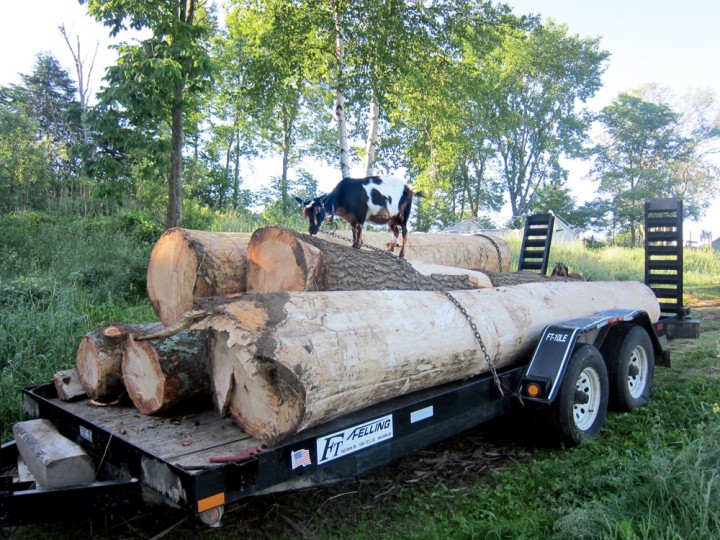Building a Homestead | Life in the Kingdom
Building a homestead taxes both body and mind. The latest installment in Ben Hewitt’s “Life in the Kingdom” series.

Setting the rafters.
Photo Credit : Penny HewittBuilding a homestead taxes both body and mind.

Photo Credit : Penny Hewitt
Almost every morning I awaken too early, my brain overwhelmed by the minutiae of our task, a frothing sea of details: materials I need to compile, people I need to call, tools I need to fix. And on top of that, the usual tasks of the season: cows to be milked, calves and pigs to be fed, the meat birds moved to a fresh swath of pasture grass. Every morning, we check the blueberries, ripening slowly in the midsummer sun; soon we’ll pick them by the gallon. For a time, I lie still, pushing my eyes shut, hoping to trick myself back into sleep, but my body feels as restless as my mind, and I soon rise into the dark for coffee and food.
If our project feels overwhelming at times, we have no one to blame but ourselves. Early on, we decided that we wanted to do all the things that we’d hired out when we built our first place. I don’t mean totally by ourselves; it was abundantly clear from the beginning that to build a barn and a house in a single summer—while developing the associated systems, maintaining our current homestead, and putting up our usual allotment of food reserves—we’d need some help. We’re prideful—but not so prideful that we don’t recognize our obvious limits. Some of those limits are related to skill, some to equipment, and some to sheer person power. In automotive-performance circles, there’s an old adage: There’s no replacement for displacement. That’s just a clever way of saying that ingenuity and technology can take you only so far; at some point, it all depends on the sheer size of your engine.

Photo Credit : Penny Hewitt
So yes, we have help (and amazing help, at that), but we’ve also taken it upon ourselves to orchestrate and participate in every aspect of site development and construction. Partly, that’s owing to finances—we simply don’t have the money to hire everything out in full—but it’s also owing to a base desire to understand the very minutiae that pull me out of sleep every morning in the four o’clock hour. Though we’d built our previous home (again, with help) and know all too well its myriad faults, we simply didn’t have the same familiarity with the systems that serve it. If for no other reason than that we’d know better how to fix those systems should they fail in the future, this time we’ve resolved to get our hands dirty.
—
The first big unknown is the septic and wastewater system. We’re fortunate that our site has perc-tested for a conventional, in-ground installation; indeed, we made our purchase-and-sale agreement contingent on the perc test, since a mound system can quickly run north of $20,000. That means that the installation should be relatively straightforward and affordable, and we’re doubly blessed in that our friend Jimmy has recently purchased an excavator and is eager to put it to the test.
Naturally, we’re happy to oblige, and the machine makes short work of clearing the site, burying the tank, and laying the leach field. The septic installation goes more smoothly than I could possibly have dreamed—a day and a half at most—and, better yet, ends up costing us a full $2,000 less than I’d budgeted. Naturally, this imbues me with a vastly inflated sense of my own capabilities (never mind that the savings are largely owing to Jimmy’s superb work and generous rates). So it’s with this inflated sense intact that we begin developing the spring.
Ah, the spring. When I first discovered the spring, emerging from the base of a ledge outcropping in the woods above the house site, I’d envisioned something simple and even quaint in form and function: a box of cedar boards, perhaps. Or maybe I’d fashion a box of fieldstone. I could see it in my mind’s eye: the cool water against the cool stone, gray on gray, pure as the source, developed thanks to a wood-handled shovel, the muscles in my back, and the sweat on my brow.
As with many aspects of building a home, however (and particularly those pertaining to water and waste), the State of Vermont has its own opinions about our spring, and thus we’re compelled to install something infinitely more complex and invasive. There will be no cedar boards or fieldstone, and unless I want to dig for six or seven months straight, there will be no wood-handled shovel. So I call Jimmy and we get to work.

Photo Credit : Penny Hewitt
In truth, it’s not that bad, although the day we lay 800 feet of water line between spring and house is one of those days that’s amusing only in hindsight. It’s August now but atypically cold, and raining not just cats and dogs but ferocious lions and saber-toothed wolves. The trench is nearly 5 feet deep and 18 inches wide, and although I endeavor to remain above grade, there’s no way to avoid clambering in and out of the trough, a maneuver that necessitates full-body contact with the freshly dug, waterlogged soil. I soon find myself shivering intermittently.
To his enduring credit, Jimmy jumps down from the dry, heated cab of his machine to help muscle the roll of pipe into place. By the end of the day, the water line is unfurled, and the two of us are a grim sight, frigid and shriveled and caked in muck. The only thing to do is to joke that someone somewhere is paying top dollar for an exfoliating mudbath treatment that looks and feels much the same. Heck, when you look at it that way, we’re getting a bargain.
—
Not long ago, I was talking to one of my magazine editors on the phone. He lives in New York City, and he expressed surprise that we were building our own place. “I didn’t think anyone did that anymore” is what he said. I thought about it for a minute and realized that I couldn’t think of anyone we know who hasn’t built his own house, isn’t currently building his own house, or doesn’t plan to someday build his own house.
In truth, this claim is a modest exaggeration—of course we know people who haven’t built and have no plans to build their own houses—but it’s not really that far off the mark. In rural northern Vermont, building your own house—or its infinitely more fraught cousin, restoring an old farmhouse—is just what you do, at least among the sort of riffraff we hang with. Partly, it has to do with simple economics: The most expensive aspect of building is generally the labor. But I’ve come to believe that in many cases, it’s owing to an entrenched ethos of thrift and pragmatism. In other words, perhaps some of these people could afford to hire people to do it, but there’s a deep-seated force compelling them to pick up the hammer and do it themselves.
I certainly don’t think that everyone should build their own houses, if only because I have a lot of friends in the building trades and I’d hate to see them out of work. But I’ve come to believe that everyone should have at least some idea of how to build a house, even if it’s only to understand the basic fundamentals of it all: how to square up a wall, frame a window opening, set a rafter, use a circular saw. Two weeks of good instruction and they’d be set.
It seems to me as though somewhere along the way we decided that our children didn’t actually need to learn the skills that are most essential to their physical well-being. The author Daniel Quinn makes the point that from even the most revered institutions of higher learning in this nation, we graduate human beings who are in a sense helpless. They can no sooner put a roof over their heads than transplant a heart; no sooner grow a carrot or slaughter a hog than fly to Mars; no sooner doctor a flesh wound or make their own medicine than dive to the bottom of the ocean. Of course, the erosion of these skills becomes self-perpetuating, as each generation husbands fewer of them than the previous one: We are less skilled than our parents, and our children will be less skilled than we are.
That’s another of the things I think about between to-do lists during the early sleepless-but-still-trying minutes of each morning in the summer of 2015. When that gets to be too heavy, I sometimes think about the old farmhouse I pass each morning on the way to our new land: a sagging porch along the front, and on it, a cushioned chair and an old chest freezer with two chainsaws atop its lid; across the road, a small herd of cows, Jerseys mostly, heads bent to the ground in search of food. I think about how on a few recent mornings, I’ve spotted a woman sitting in the cushioned chair, reading a book.
Then I think about hitting the gravel road. I’ll roll down the truck window, hear the ping of small stones against the rocker panels, breathe deeply of the midsummer air.
And then, once in a while, if I’m really lucky, I’ll drift back to sleep.
Ben Hewitt
The Hewitt family runs Lazy Mill Living Arts, a school for practical skills of land and hand. Ben's most recent book is The Nourishing Homestead, published by Chelsea Green.
More by Ben Hewitt

